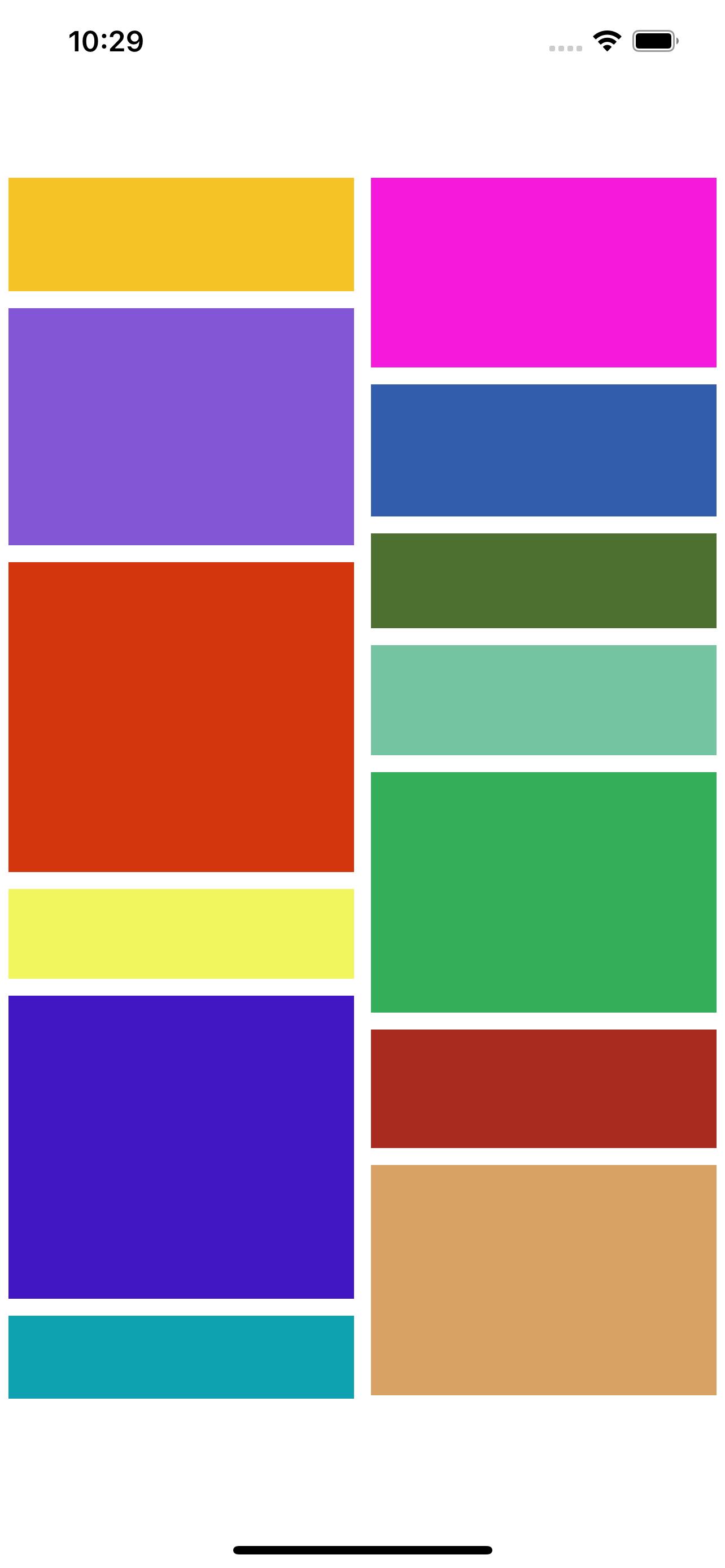ios 瀑布流怎么自动滚动到指定cell
Posted
tags:
篇首语:本文由小常识网(cha138.com)小编为大家整理,主要介绍了ios 瀑布流怎么自动滚动到指定cell相关的知识,希望对你有一定的参考价值。
参考技术A 实际上就是tableview的cell内嵌一个collectionview,然后还可以类似tableview向上滑动加载更多数据(但这个是向左滑动加载跟多数据)[iOS开发]UICollectionView瀑布流的学习
写在前面
我们很多都会使用 UITableView ,UICollectionView 瀑布流也是与其十分相似的一个十分强大的控件。
好处有很多:
- 支持水平和垂直两种方向的布局
- 通过layout配置方式进行布局
- 类似于TableView中的cell特性外,CollectionView中的Item大小和位置可以自由定义
- 通过layout布局回调的代理方法,可以动态的定制每个item的大小和collection的大体布局属性
- 更加强大的一点是可以完全自定义一套layout布局方案,可以实现意想不到的效果
使用
上代码:
- (void)viewDidLoad
[super viewDidLoad];
// Do any additional setup after loading the view.
UICollectionViewFlowLayout *layout = [[UICollectionViewFlowLayout alloc] init];
// 设置item的行间距和列间距
layout.minimumInteritemSpacing = 0;
layout.minimumLineSpacing = 5;
// 设置item的大小
CGFloat itemW = (selfWidth - 25) / 4 ;
// layout.itemSize = CGSizeMake(itemW, itemW);
// 设置每个分区的 上左下右 的内边距
layout.sectionInset = UIEdgeInsetsMake(5, 5, 5, 5);
// 设置区头和区尾的大小
layout.headerReferenceSize = CGSizeMake(selfWidth, 65);
layout.footerReferenceSize = CGSizeMake(selfWidth, 65);
// 设置分区的头视图和尾视图 是否始终固定在屏幕上边和下边
// layout.sectionHeadersPinToVisibleBounds = YES;
// layout.sectionFootersPinToVisibleBounds = YES;
// 设置滚动条方向
layout.scrollDirection = UICollectionViewScrollDirectionVertical;
// layout.scrollDirection = UICollectionViewScrollDirectionHorizontal;
_myCollectionView = [[UICollectionView alloc] initWithFrame:CGRectMake(0, 100, selfWidth, selfHeight - 200)collectionViewLayout:layout];
[self.view addSubview:_myCollectionView];
//使用前先注册
[_myCollectionView registerClass:[MyCollectionViewCell class] forCellWithReuseIdentifier:@"myFirstCellId"];
[_myCollectionView registerClass:[MyCollectionReusableHeaderView class] forSupplementaryViewOfKind:UICollectionElementKindSectionHeader withReuseIdentifier:@"myFirstHeader"];
[_myCollectionView registerClass:[UICollectionReusableView class] forSupplementaryViewOfKind:UICollectionElementKindSectionFooter withReuseIdentifier:@"myFirstFooter"];
//设置代理
_myCollectionView.delegate = self;
_myCollectionView.dataSource = self;
_myCollectionView.allowsSelection = YES;
#pragma mark - collectionview 数据源方法
- (NSInteger)numberOfSectionsInCollectionView:(UICollectionView *)collectionView
return 2; //返回section数
- (NSInteger)collectionView:(UICollectionView *)collectionView numberOfItemsInSection:(NSInteger)section
return 12; //每个section的Item数
- (UICollectionViewCell *)collectionView:(UICollectionView *)collectionView cellForItemAtIndexPath:(NSIndexPath *)indexPath
MyCollectionViewCell *cell = [_myCollectionView dequeueReusableCellWithReuseIdentifier:@"myFirstCellId" forIndexPath:indexPath];
// 外界在此给Item添加模型数据
return cell;
//根据indexpath设置每个item大小
- (CGSize)collectionView:(UICollectionView *)collectionView layout:(nonnull UICollectionViewLayout *)collectionViewLayout sizeForItemAtIndexPath:(nonnull NSIndexPath *)indexPath
CGFloat itemW = (selfWidth - 25) / 4 ;
if ((indexPath.row - 1) % 3 == 0)
return CGSizeMake(itemW * 2 + 5, itemW);
else
return CGSizeMake(itemW, itemW);
#pragma mark - 头部视图
- (UICollectionReusableView *)collectionView:(UICollectionView *)collectionView viewForSupplementaryElementOfKind:(NSString *)kind atIndexPath:(NSIndexPath *)indexPath
if ([kind isEqualToString:UICollectionElementKindSectionHeader])
UICollectionReusableView *headView = [collectionView dequeueReusableSupplementaryViewOfKind:UICollectionElementKindSectionHeader withReuseIdentifier:@"myFirstHeader" forIndexPath:indexPath];
// ID必须与注册ID一样
return headView;
else
UICollectionReusableView *footView = [collectionView dequeueReusableSupplementaryViewOfKind:UICollectionElementKindSectionFooter withReuseIdentifier:@"myFirstFooter" forIndexPath:indexPath];
// ID必须与注册ID一样
footView.backgroundColor = [UIColor grayColor];
return footView;
- (CGSize)collectionView:(UICollectionView *)collectionView layout:(UICollectionViewLayout *)collectionViewLayout referenceSizeForHeaderInSection:(NSInteger)section
return CGSizeMake(selfWidth, 65);
// return CGSizeZero;
- (CGSize)collectionView:(UICollectionView *)collectionView layout:(UICollectionViewLayout *)collectionViewLayout referenceSizeForFooterInSection:(NSInteger)section
return CGSizeMake(selfWidth, 65);
// return CGSizeZero;
#pragma mark - 点击事件
- (void)collectionView:(UICollectionView *)collectionView didSelectItemAtIndexPath:(NSIndexPath *)indexPath
[collectionView deselectItemAtIndexPath:indexPath animated:YES];
NSLog(@"%@", indexPath);
效果:

此外,它的layout布局也可以自定义,实现一些有趣的功能:
调用顺序是:
- 使用"prepareLayout"方法去执行一些CollectionView所需要的布局信息的预先计算操作。
- 使用"collectionViewContentSize"方法去返回根据你最初计算的整个内容区域的总体大小。
- 使用"layoutAttributesForElementsInRect:"方法来返回指定区域的单元格与视图属性。
下面给出一个样例:
#pragma mark - 下面的是自定义的layout
- (void)viewDidLoad
[super viewDidLoad];
// Do any additional setup after loading the view, typically from a nib.
MyLayout * layout = [[MyLayout alloc]init];
layout.scrollDirection = UICollectionViewScrollDirectionVertical;
layout.itemCount = 100;
layout.sectionInset = UIEdgeInsetsMake(5, 5, 5, 5);
layout.heightArray = [[NSMutableArray alloc] init];
for (int i = 0; i < 100; ++i)
[layout.heightArray addObject:[NSNumber numberWithFloat:arc4random() % 150 + 40]];
UICollectionView * collect = [[UICollectionView alloc] initWithFrame:CGRectMake(0, 100, selfWidth, selfHeight - 200) collectionViewLayout:layout];
collect.delegate = self;
collect.dataSource = self;
[collect registerClass:[UICollectionViewCell class] forCellWithReuseIdentifier:@"cellid"];
[self.view addSubview:collect];
-(NSInteger)numberOfSectionsInCollectionView:(UICollectionView *)collectionView
return 1;
-(NSInteger)collectionView:(UICollectionView *)collectionView numberOfItemsInSection:(NSInteger)section
return 100;
-(UICollectionViewCell *)collectionView:(UICollectionView *)collectionView cellForItemAtIndexPath:(NSIndexPath *)indexPath
UICollectionViewCell * cell = [collectionView dequeueReusableCellWithReuseIdentifier:@"cellid" forIndexPath:indexPath];
cell.backgroundColor = [UIColor colorWithRed:arc4random() % 255 / 255.0 green:arc4random() % 255 / 255.0 blue:arc4random() % 255 / 255.0 alpha:1];
return cell;
@implementation MyLayout
//这个数组就是我们自定义的布局配置数组
NSMutableArray * _attributeAttay;
//数组的相关设置在这个方法中
//布局前的准备会调用这个方法
- (void)prepareLayout
if (!_count)
_count = [NSNumber numberWithInt:0];
_attributeAttay = [[NSMutableArray alloc] init];
[super prepareLayout];
//演示方便 我们设置为静态的2列
//计算每一个item的宽度
float WIDTH = ([UIScreen mainScreen].bounds.size.width - self.sectionInset.left - self.sectionInset.right - self.minimumInteritemSpacing) / 2;
//定义数组保存每一列的高度
//这个数组的主要作用是保存每一列的总高度,这样在布局时,我们可以始终将下一个Item放在最短的列下面
CGFloat colHight[2] = self.sectionInset.top, self.sectionInset.bottom;
//itemCount是外界传进来的item的个数 遍历来设置每一个item的布局
for (int i = 0; i < _itemCount; i++)
//设置每个item的位置等相关属性
NSIndexPath *index = [NSIndexPath indexPathForItem:i inSection:0];
//创建一个布局属性类,通过indexPath来创建
UICollectionViewLayoutAttributes *attris = [UICollectionViewLayoutAttributes layoutAttributesForCellWithIndexPath:index];
//随机一个高度 在40——190之间
CGFloat height = 0;
if (_heightArray.count > _count.intValue)
NSNumber *num = _heightArray[_count.intValue];
_count = [NSNumber numberWithInt:_count.intValue + 1];
height = num.floatValue;
//哪一列高度小 则放到那一列下面
//标记最短的列
int width = 0;
if (colHight[0] < colHight[1])
//将新的item高度加入到短的一列
colHight[0] = colHight[0] + height + self.minimumLineSpacing;
width = 0;
else
colHight[1] = colHight[1] + height + self.minimumLineSpacing;
width = 1;
//设置item的位置
attris.frame = CGRectMake(self.sectionInset.left + (self.minimumInteritemSpacing + WIDTH) * width, colHight[width] - height - self.minimumLineSpacing, WIDTH, height);
[_attributeAttay addObject:attris];
//设置itemSize来确保滑动范围的正确 这里是通过将所有的item高度平均化,计算出来的(以最高的列位标准)
if (colHight[0] > colHight[1])
self.itemSize = CGSizeMake(WIDTH, (colHight[0] - self.sectionInset.top) * 2/ _itemCount - self.minimumLineSpacing);
else
self.itemSize = CGSizeMake(WIDTH, (colHight[1] - self.sectionInset.top) * 2/ _itemCount - self.minimumLineSpacing);
//这个方法中返回我们的布局数组
- (NSArray<UICollectionViewLayoutAttributes *> *)layoutAttributesForElementsInRect:(CGRect)rect
return _attributeAttay;
实现效果:

以上是关于ios 瀑布流怎么自动滚动到指定cell的主要内容,如果未能解决你的问题,请参考以下文章